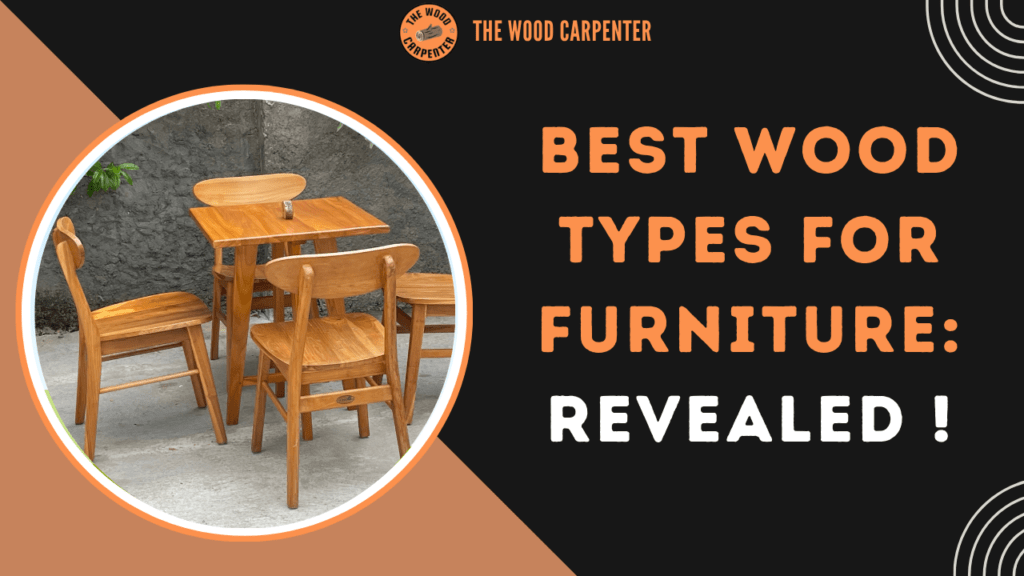
Knowing the Wood types are very important for your furniture. They decide how long your furniture will last, how it looks, how easy it is to clean, and the feel of your home.
There are many kinds of wood, and each one has its own good and bad points. Learning about these wood types will help you choose the best one for your needs and style.
Understanding Wood Categories
1. Solid Wood
Solid wood furniture is made from full pieces of wood, which makes it very strong and long-lasting. It also looks natural. It can be fixed and refinished several times, which makes it a great choice for heirloom-quality items.
Examples: Oak, teak, walnut, mahogany, maple, cherry, rosewood.
2. Engineered Wood
Plywood, MDF (Medium Density Fiberboard), and particleboard are all examples of engineered wood. These are manufactured by binding the wood fibers or veneers together with the adhesives. Engineered wood is usually less expensive and more stable than solid wood, but it is also less durable.
3. Veneer Wood
A thin layer of high-quality wood is glued to a core of manufactured wood to make veneer furniture. This makes it look like solid wood for less money, but how long it lasts relies on how good the core material is.
Hardwoods vs. Softwoods

Hardwoods: Hardwoods come from trees that lose their leaves in the fall, like oak, walnut, maple, and teak. Known for being strong, dense, and long-lasting, which makes it great for furniture that gets a lot of wear.
Softwoods: It come from the coniferous trees like pine, cedar & fir. It’s lighter, easier to work with, and typically cheaper, but it’s usually not as strong.
Popular Wood Types for Furniture
1. Oak
Type: Hardwood
Color: Light to medium brown, sometimes with a reddish hue
Grain: Prominent, attractive grain patterns
Best For: Tables, cabinets, beds, and flooring
Pros: Extremely durable, resists scratches, ages beautifully
Cons: Heavier and more expensive than many softwoods
2. Teak
Type: Hardwood
Color: Golden brown
Grain: Straight, smooth, oily texture
Best For: Indoor and outdoor furniture, flooring
Pros: It is highly durable, water and insect resistant, low maintenance.
Cons: Expensive due to limited supply
Also read: Acacia vs Teak: Comparing Two Popular Hardwoods
3. Walnut
Type: Hardwood
Color: Rich chocolate brown, sometimes with lighter streaks
Grain: Straight to wavy, luxurious appearance
Best For: High-end furniture, headboards, desks
Pros: Strong, stable, resists warping, elegant look
Cons: Expensive, limited availability in large boards
All About Black Walnut Wood: Characteristics, Uses
4. Mahogany
Type: Hardwood
Color: Deep reddish-brown
Grain: Straight, fine, even
Best For: Cabinets, classic and antique-style pieces
Pros: Strong, resists swelling/shrinking, polishes to a high sheen
Cons: Expensive, sustainability concerns
5. Maple
Type: Hardwood
Color: Creamy white to light reddish-brown
Grain: Subtle, straight
Best For: Dressers, kitchen furniture, cabinets
Pros: Hard, durable, resists dents, takes stain well
Cons: Light color shows blemishes easily
6. Cherry
Type: Hardwood
Color: Light pink to reddish-brown, darkens with age
Grain: Smooth, fine, straight
Best For: Classic furniture, cabinets
Pros: Ages beautifully, smooth grain, durable
Cons: Expensive, prone to scratches
7. Pine
Type: Softwood
Color: Pale yellow to light brown, visible knots
Grain: Straight, rustic appearance
Best For: Rustic or farmhouse-style furniture, budget-friendly options
Pros: Lightweight, affordable, easy to work with
Cons: Prone to dents and scratches
8. Cedar
Type: Softwood
Color: Pale yellow to reddish-brown
Grain: Straight, aromatic
Best For: Outdoor furniture, storage chests
Pros: Naturally insect and rot resistant, pleasant aroma
Cons: Softer, can show wear over time
9. Acacia
Acacia vs Teak: Comparing Two Popular Hardwoods
Type: Hardwood
Color: Rich brown
Grain: Varied, often dramatic
Best For: Indoor/outdoor furniture, rustic pieces
Pros: Durable, water-resistant, beautiful grain
Cons: Heavy, can be expensive
10. Birch
Type: Hardwood
Color: Pale yellow
Grain: Fine, even
Best For: Modern furniture, support structures
Pros: Strong, affordable
Cons: Can be difficult to stain evenly
11. Beech
Type: Hardwood
Color: Light, pale
Grain: Fine, straight
Best For: Chairs, children’s furniture
Pros: Strong, flexible, shock-resistant
Cons: Susceptible to moisture, not ideal for outdoors
12. Mango Wood
Type: Hardwood
Color: Golden brown, often with unique grain patterns
Best For: Tables, dressers, accent furniture
Pros: Sustainable, affordable, easy to work with
Cons: Can be inconsistent in color and texture
Quick Comparison Table
| Wood Type | Durability | Cost | Appearance | Best For | Maintenance |
| Oak | Very High | High | Prominent grain | Tables, beds, cabinets | Low |
| Teak | Very High | Very High | Golden, smooth | Outdoor/indoor, luxury | Very low |
| Walnut | High | High | Dark, elegant | Heirloom, accent pieces | Low |
| Mahogany | High | High | Deep red-brown | Classic, antique furniture | Low |
| Maple | High | Moderate | Light, subtle grain | Cabinets, kids’ furniture | Low |
| Cherry | High | High | Reddish, ages well | Classic, formal pieces | Low |
| Pine | Moderate | Low | Rustic, knotty | Budget, rustic furniture | Moderate |
| Cedar | Moderate | Moderate | Aromatic, pale | Outdoor, storage | Low |
| Acacia | High | Moderate | Dramatic, rich grain | Rustic, indoor/outdoor | Low |
| Birch | High | Low | Light, plain | Modern, support pieces | Low |
| Beech | High | Low | Pale, smooth | Chairs, kids’ furniture | Low |
| Mango | Moderate | Low | Unique patterns | Accent, eco-friendly | Moderate |
How to Choose the Best Wood for Your Furniture
Purpose: For heavy-use products (dining tables, beds), consider robust hardwoods like oak, teak, or walnut.
Location: For outdoor furniture, choose woods that naturally resist moisture and bugs, such teak or cedar.
Budget: Pine, mango, and birch offer affordability, while still providing good looks and function.
Style: The wood’s grain, color, and finish should go well with the rest of your home. For traditional styles, use walnut and mahogany. For modern trends, use maple and birch.
Sustainability: Look for woods that are FSC-certified or fast-growing species like mango and acacia if you want to be eco-friendly.
Frequently Asked Questions (FAQs)
1. What is the most durable wood for furniture?
Teak and oak are among the most durable woods, with excellent resistance to wear, insects, and moisture. Walnut and mahogany also offer high durability for indoor pieces.
2. Are hardwoods always better than softwoods?
Not necessarily. Hardwoods are generally stronger and last longer, but softwoods like pine and cedar can be ideal for certain styles, budgets, or outdoor use.
3. Is engineered wood good for furniture?
Engineered wood (like plywood and MDF) is stable and cost-effective, but it doesn’t match the longevity or repairability of solid wood. It’s suitable for budget-friendly or lightweight furniture.
4. How do I maintain wooden furniture?
- Dust regularly with a soft cloth.
- Use coasters and mats to prevent stains.
- Avoid direct sunlight and excessive moisture.
- Polish or oil periodically, depending on the wood type.
5. What kind of wood is ideal for making furniture for the outdoors?
Because it has natural oils and resistance to weather, teak is the best wood for outdoor furniture. Cedar is also a wonderful choice since it keeps bugs away.
6. What are the differences between solid wood and veneer?
Veneer is formed of a thin layer of wood over a core of a engineered wood, while solid wood is manufactured from a single piece of lumber. Veneer can appear like solid wood for less money, but solid wood is stronger and can be refinished.
7. Is sustainable wood available for furniture?
Yes, options like FSC-certified woods, mango, and acacia are considered sustainable due to responsible harvesting and fast growth rates.
Final Thoughts
You need to think about style, function, price, and sustainability when choosing the perfect wood for your furniture. You can make sure your furniture looks great and lasts a long time by learning about the different varieties of wood and its qualities.
There is a perfect variety of wood for every home and lifestyle, whether you like the classic look of walnut, the rustic charm of pine, or the eco-friendly appeal of mango wood.
Before you buy anything, always talk to furniture specialists or stores you trust and think about what you really need.

